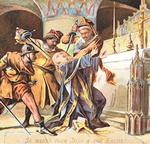Catholic Dictionary
Find accurate definitions of over 5,000 Catholic terms and phrases (including abbreviations). Based on Fr. John Hardon's Modern Catholic Dictionary, © Eternal Life. Used with permission.
Random Term from the Dictionary:
BASILICA OF ST. PETER
The patriarchal church adjoining the Vatican Palace of the Pope. In A.D. 67, St. Peter was executed in the circus of Nero near the foot of the obelisk that was brought from Egypt and that stands in the center of the piazza in front of St. Peter's Basilica. In A.D. 90, Pope St. Anacletus marked the grave by building a small oratory over the spot that Constantine, destroying the old circus, hoped to place within the foundations of the new cathedral. The first basilica had lasted for 1100 years when Pope Nicholas V determined to build a more pretentious edifice. Work progressed very slowly. Successive popes engaged Rosselino (1439-1507), Alberti (1474-1515), Bramante (1444-1514), Michelangelo (1475-1564), Maderna (1556-1629), and Bernini (1598-1680). The basilica was finally finished after being in process of construction for 176 years. It was dedicated with great ceremony by Pope Urban VII in 1626. The famed colonnade surrounding the piazza, four columns deep, was designed by Bernini. The top is surmounted by 126 statues of saints each twelve feet in height. Over the front entrance is the Loggia della Benedizione, from which the Pope imparts benediction. From the portico five entrances lead into the basilica -- the first is the Porta Santa, opened only during the Holy Year. The central entrance has the noted bronze doors from the first cathedral depicting the life of Christ and the Virgin. The nave is the longest in the world, blanked by fluted pillars with the niches that contain the huge sculptured statues of the founders of the religious orders. This leads to the high altar, with its bronzed and gilt-ornamented canopy done by Bernini in 1633. In front of it is the circular marble balustrade, with its ninety-five lamps burning day and night, leading below to the bronze sarcophagus above which is the gold cross of St. Peter. At the left as one ascends from the Confessio is the fifth-century bronze statue of the first Pope from the first basilica of A.D. 445. The right foot of bronze has been worn and polished by the millions who, passing by, have kissed Peter's foot. Beyond the transept is the tribune that contains the bronze reliquary enclosing the ancient episcopal wooden chair of the first Vicar of Christ. Numerous papal tombs are in the tribune and aisles, notably Pope Paul III's, considered the finest of the monuments in St. Peter's. The world famous Michelangelo Pietà is in the first chapel of the right aisle with the youthful Mother and her dead Son. In the crypt, in the thirteen feet between the pavement of the new and old cathedrals, are the tombs of many popes, including Pope Adrian IV, the only Englishman to be a successor of Peter, and St. Pius X, best known as the Pope of the Blessed Sacrament. St. Peter's body lies in a vault beneath the high altar. Recent scientific excavations have established authenticity of his remains.






